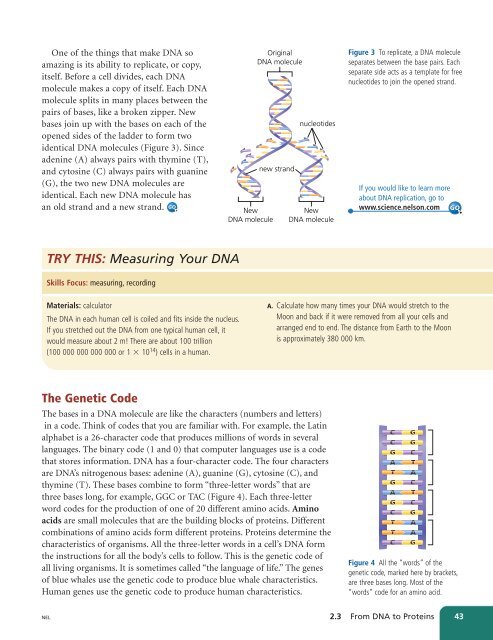Unit A Reproduction
Unit A Reproduction
Unit A Reproduction
Create successful ePaper yourself
Turn your PDF publications into a flip-book with our unique Google optimized e-Paper software.
One of the things that make DNA so<br />
amazing is its ability to replicate, or copy,<br />
itself. Before a cell divides, each DNA<br />
molecule makes a copy of itself. Each DNA<br />
molecule splits in many places between the<br />
pairs of bases, like a broken zipper. New<br />
bases join up with the bases on each of the<br />
opened sides of the ladder to form two<br />
identical DNA molecules (Figure 3). Since<br />
adenine (A) always pairs with thymine (T),<br />
and cytosine (C) always pairs with guanine<br />
(G), the two new DNA molecules are<br />
identical. Each new DNA molecule has<br />
an old strand and a new strand. GO<br />
New<br />
DNA molecule<br />
Original<br />
DNA molecule<br />
new strand<br />
nucleotides<br />
New<br />
DNA molecule<br />
Figure 3 To replicate, a DNA molecule<br />
separates between the base pairs. Each<br />
separate side acts as a template for free<br />
nucleotides to join the opened strand.<br />
If you would like to learn more<br />
about DNA replication, go to<br />
www.science.nelson.com GO<br />
TRY THIS: Measuring Your DNA<br />
Skills Focus: measuring, recording<br />
Materials: calculator<br />
The DNA in each human cell is coiled and fits inside the nucleus.<br />
If you stretched out the DNA from one typical human cell, it<br />
would measure about 2 m! There are about 100 trillion<br />
(100 000 000 000 000 or 1 10 14 ) cells in a human.<br />
A. Calculate how many times your DNA would stretch to the<br />
Moon and back if it were removed from all your cells and<br />
arranged end to end. The distance from Earth to the Moon<br />
is approximately 380 000 km.<br />
The Genetic Code<br />
The bases in a DNA molecule are like the characters (numbers and letters)<br />
in a code. Think of codes that you are familiar with. For example, the Latin<br />
alphabet is a 26-character code that produces millions of words in several<br />
languages. The binary code (1 and 0) that computer languages use is a code<br />
that stores information. DNA has a four-character code. The four characters<br />
are DNA’s nitrogenous bases: adenine (A), guanine (G), cytosine (C), and<br />
thymine (T). These bases combine to form “three-letter words” that are<br />
three bases long, for example, GGC or TAC (Figure 4). Each three-letter<br />
word codes for the production of one of 20 different amino acids. Amino<br />
acids are small molecules that are the building blocks of proteins. Different<br />
combinations of amino acids form different proteins. Proteins determine the<br />
characteristics of organisms. All the three-letter words in a cell’s DNA form<br />
the instructions for all the body’s cells to follow. This is the genetic code of<br />
all living organisms. It is sometimes called “the language of life.” The genes<br />
of blue whales use the genetic code to produce blue whale characteristics.<br />
Human genes use the genetic code to produce human characteristics.<br />
Figure 4 All the “words” of the<br />
genetic code, marked here by brackets,<br />
are three bases long. Most of the<br />
“words” code for an amino acid.<br />
NEL<br />
2.3 From DNA to Proteins 43

















